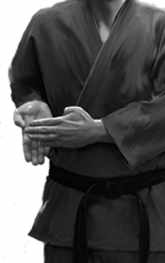By definition, Signifying (A.K.A. signing) can be described as a hand gesture that has the purpose of indicating a specific form in a non-verbal way. This hand gesture is typically displayed prior to the execution of a form. Its purpose, as stated, is to display to any observers which form is to be executed with any verbal queues. This is accomplished by a backing hand (A.K.A. backstop hand) and a foreground hand (A.K.A. signifying hand). The backing hand is used to indicate lower forms from higher forms and to indicate standard execution from modified execution. The fingers of the foreground hand are used to designate the form being executed.
In the case of Form Four, the foreground hand extends four fingers which cover the backing hand both perpendicular to, horizontally, and parallel to, vertically - at the chambered position of the backing hand. This signification is executed from an attention stance.

"Signifying" Form Four
The history of signifying a form comes from the early competition days (prior to the 1970‘s). At this time, the participant was not allowed to talk to the presiding judges. So, to inform the audience and judges as to which form was to be executed, the signification was added at the beginning. Also, the display was shown on both sides of the body, so as to cover a 180-degree radius of potential observers.